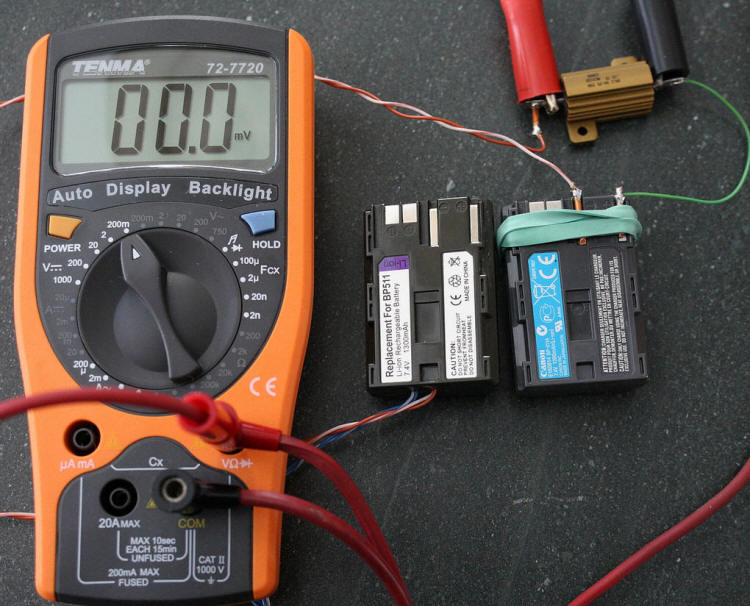 |
||||
  |
    |
|||
|
||||
|
I'm going to step out of an engineering mindset and not
be 100% accurate, but "good enough" for this discussion. In other words,
I'm sacrificing some accuracy and precision to error on the side of
readability. |
||||
|
The most common analogy for electricity is water - if you put water in a jug and run a tube out of the jug so water flows through the tube, the water itself is the current, measured in Amps and the pressure pushing that water through the tube is the voltage, measured in Volts. Together, they can do work, measured in watts, and for batteries the watts of power is the product of the volts * the amps of capacity. To make things more straightforward, I'm ignoring watts and the conversions throughout this article. So the water in our jug - the current - is our capacity. As you start using the water, it drains until there is nothing left, at which point your battery is dead (and so is your camera!). 1390 mAh means you can draw 1390 milliamps for one hour before the battery is empty. Or you can draw half that (1390/2 = 695 mA) for two hours before the battery is empty. Or you can draw 1/10th of the capacity, 139 milliamps for 10 hours before the battery is empty. On the other side, you can draw twice the current, or 1390 * 2 = 2780 milliamps for 1/2 hour and have an empty battery. To very briefly touch some of the subtleties, battery capacity is specified for a new battery - they degrade with time and charge / discharge cycles, so your 2 year old battery won't have the same capacity as a new one. The capacity is specified at a specific temperature, so if your battery is cold it won't have the same ability to give up all its current to the camera. If you've left the battery in a hot car every day over the summer, it has also reduced its capacity. In other words, I'm talking about a best case scenario here. The last bit of data here is that 1 Amp = 1000 milliamps. In electrical engineering, metric system prefixes are everywhere. Enough with the engineering! So what did you do? If you read the other article, I did the same thing I did then only for a modern Canon EOS DSLR. Then I measured various characteristics to determine how much current is consumed by the camera's various features. This way, when you use a feature you can have in the back of your mind "This is how much of my battery this feature is consuming per minute, shot, or some other measure." With that knowledge, you can possibly decide to change how you use your camera and get the most out of it by turning on or off features based on what you have for battery capacity. This shows my test rig. Starting with a 3rd party BP511 clone battery on the left with the white and purple label, I opened it up, removed the batteries, and attached wires to the connectors. Once done, this became a "Dummy battery" that was used to bring the internal camera connections out. Once connected to a real BP-511a battery, I could then power the camera and measure how much current the camera was consuming when the camera was doing various tasks. Results! I measured all kinds of things - Image Stabilization on a few different lenses, taking a picture, servo mode and the camera constantly adjusting the focus, the draw of different types of autofocus motors (USM, the older AFD in my EF 35-70mm lens, ...) ... more than you can imagine. If I get enough requests, I'll be happy to publish raw data. But the biggest single thing you can do to get the most shots out of a single battery is this: KEEP THE LCD OFF AS MUCH AS POSSIBLE! When the LCD is lit, that is the biggest continuous drain your camera will place on your batteries. The biggest current spike is actually taking a picture. Those motors that lift the mirror, open the shutter, and move the mirror back down again suck a big spike. But it is only for a fraction of a second, so it isn't that bad. But it does need a big spike - that is why a marginal battery showing one bar on the display might turn into an instantly empty battery flashing icon on the display when you try to take a picture. The high current draw of the motors can't get enough juice, the camera detects this, and what you thought was a half-full battery turns into an empty battery. The built-in flash is also a big draw, but that drops once the flash is charged. But that LCD, the folks that chimp on it and review photos a lot, those are the cases where your battery never seems to last as many shots as you hoped. In our case, the feature of the EOS 50D where the back LCD display shows all the functions of the camera and is on all the time will suck the batteries dry faster than any other "feature". I didn't measure the EOS Rebel cameras, but I imagine the results would be similar with those as that power has to come from somewhere. If you must keep that LCD on, turning the brightness down will help. Again, if I see enough requests for raw data, I'll publish it. Shoot me an email! I can be reached at EOS <at> dascc <dot> com. David Soussan Things I measured: Off
|
||||
